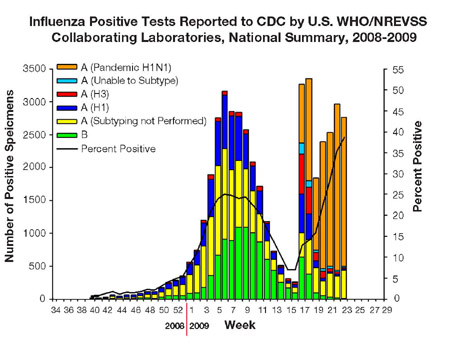Clinical labs continue see higher-than-normal flu activity in what is typically the off-season
New cases of A/novel H1N1 continue to show up in the United States and worldwide. It means that influenza activity at clinical laboratories is higher than normal for this time of year. These continuing influenza cases affirm why public health officials expect a busy flu season this fall and winter.
In fact, data from the federal Centers for Disease Control and Prevention (CDC) show that overall influenza activity decreased in the United States in recent weeks compared to late April and early May. At the same time, the novel A/H1N1 flu has spawned a second flu season this year, extending into the summer months of 2009.
This “second flu season” in the United States—and the large number of A/novel H1N1 cases relative to other flu strains—is dramatically illustrated the chart presented here. It was compiled by the CDC. Clinical lab managers and pathologists will find this chart useful to show laboratory staff why there are unusual patterns of influenza cases for this time of year.
 Center for Disease Control Influenza Graph
Center for Disease Control Influenza Graph
During the week ending June 13 (week 23), seasonal influenza A (H1), A (H3), and B viruses co-circulated at low levels with pandemic influenza A/H1N1, the CDC said. In addition, over 98% of all sub-typed influenza A viruses reported to the CDC were the pandemic influenza novel A/H1N1 virus. The CDC compiles this data from laboratories labs doing surveillance testing. The surveillance lab network is organized collaboratively in the United States with the World Health Organization (WHO) and National Respiratory and Enteric Virus Surveillance System (NREVSS) .
During the U.S. flu season of 2008-09, influenza A (H1), A (H3), and B viruses have co-circulated, but then on April 15 and 17, 2009, CDC confirmed the first two cases of pandemic influenza novel A/H1N1 virus in the United States. As of June 19, the CDC had 21,449 confirmed and probable infections with novel A/H1N1 and 87 deaths reported by the CDC and state and local public health departments.
In reporting on these data from the CDC, the blog, Effect Measure had a particularly insightful comment on the numbers, saying:
“CDC has another snapshot of what the flu surveillance system is seeing up through week 23 (ending June 13). It shows flu still circulating in many communities at a time when most seasonal flu is normally at a very low level. Indeed of the 2,765 specimens tested in CDC’s network of 150 laboratories, virtually all of the roughly 40% were influenza A (seasonal influenza B has all but disappeared; the others were not influenza). Not all the flu A viruses were or could be subtyped, but of those that were or could be, 98% were novel H1N1. In other words, there’s lots of flu around, but essentially none are the seasonal strains of last winter. They are almost all pandemic H1N1.”
The Effect Measure report also explained the CDC flu table presented here, commenting that, “The end of normal flu season has given way to a second flu season with novel H1N1.”
Since this report in Effect Measure, the CDC has issued another similar weekly report for week 24 (June 14-20). In this report, the CDC said influenza activity decreased in the United States. However, there were still higher levels of influenza-like illness than is normal for this time of year. Of the specimens tested by the U.S. WHO and NREVSS collaborating laboratories and reported to the CDC Influenza Division, 3,286 (or 41.9%) were positive for influenza, the CDC said in its latest report. The CDC also reported that over 99% of all subtyped influenza A viruses were the novel A/H1N1 virus.
This information update provides clinical laboratory managers and pathologists with a useful overview of current trends in the ongoing outbreak of A/Novel H1N1. Evidence points to a busy flu season, particularly since public health officials are concerned that this flu strain could evolve into a more virulent or lethal influenza virus.
Related Articles:
Flu View: 2008-2009 Influenza Season Week 24 ending June 20, 2009



